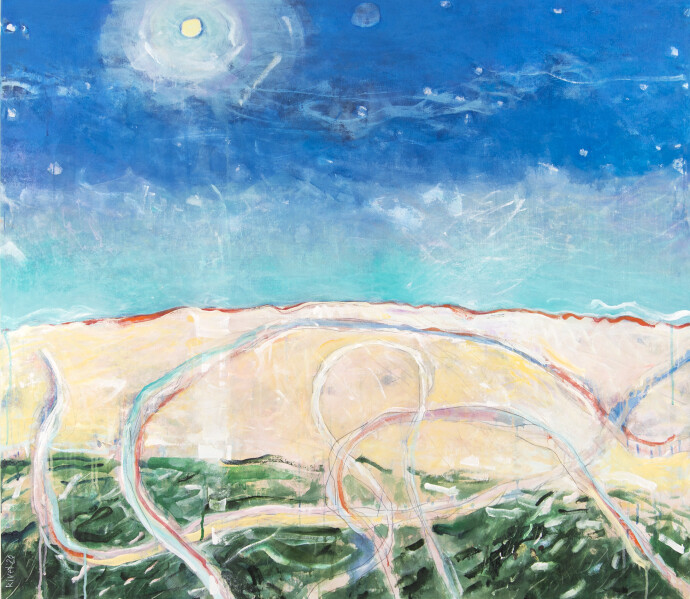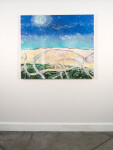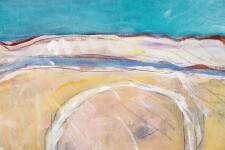Above the Beach No 5
More Works By Rick Rivet Acrylic on Canvas 2020
42 × 48 in
106.68 × 121.92 cm
$6,500
About Above the Beach No 5
Above the Beach No 5 is a part of a series in which Rick Rivet is probing the environmental crisis in Arctic regions. The polar territories of Canada are under serious and imminent threat resulting from pollution, global warming, and poor resource management. Sport hunting is depleting animal resources that local populations need to survive, global warming is melting the polar icecaps threatening polar bear populations, and lead pollution is resulting in poisonous biomagnification levels in some sea animals while plastic pollution is trapping and suffocating others. The major degradative pollution began in the 1950s from nuclear testing which introduced radioactive isotopes produced by nuclear fission into plant and animal life, the effects of which are lethal and long-lasting. The melting resulting from global warming has increased to such a degree that the previously, and notoriously, challenging Northwest passage has opened wide now allowing tourist ships to glide through, further contributing to oil pollution and environmental wear and tear.The red horizon line in Above the Beach No 5 sketching the intersection of the land with the sky demarcates the pollution that is penetrating every pore of our environment. The snaking cream-coloured lines in the foreground indicate the different paths taken, the journeys that were cut short, the short-sighted policies that taxed the land and fell flat leaving no solutions, the hunting paths, the lack of direction and clear vision. Nevertheless, this painting is not about doom it is about hope. The shock of bright green grass edging the bottom is flecked with yellow from the radiating sun. The sun, high in a cold blue arctic sky, is twice hallowed by a glow of white suggesting reverence for its ability to regenerate life and for us to carry forward together if we build a sustainable and long-sighted path together.
Richard James Rivet was born in the remote area of Aklavik in the Northwest Territories of Canada in 1949. His early years were spent growing up in the delta in a Metis family which made their living by trapping, hunting and fishing. Of Metis background, Rivet's Indigenous roots, and his experience in growing up in Canada's North, have been important factors in his development as an artist. Since 1989, Rivet has worked fulltime on his artwork, mainly concentrating in acrylic painting, mixed media and collage on canvas, with some drawing.
Influences in his artwork are varied and derive from Shamanistic imagery of ancient peoples the world over (North American Indian, Inuit, Australian Aborigine, Norse, Oceanic, Siberian). Equally influential are Western and contemporary influences from various artists and art movements (such as: Edvard Munch, German Expressionism, Abstract Expressionism, Antoni Tapies, and Paterson Ewen, to name a few). His work involves combining and re-interpreting the iconography of various Indigenous peoples in a contemporary perspective. Earlier works challenged the history and mentality of colonialism while later works explore the journey of the human spirit. Rivet's approach is introspective, involving the existential nature of being - the spiritual, the psychic and the physical aspects of human experience.
Rivet has four degrees from three universities. In addition to receiving a Master's degree in Fine Arts from the University of Saskatchewan, Rick has been the recipient of over twenty awards, scholarships and bursaries, including a Fellowship from the Eiteljorg Museum in Indianapolis, and the Andy Warhol Foundation Fellowship Residency Program for the Heard Museum in Phoenix Arizona. His art is exhibited nationally and internationally.








